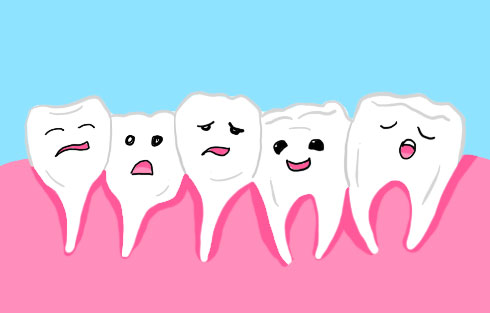Orthodontic treatment is necessary to treat various orthodontic issues, from malocclusions (bad bites) to jaw irregularities. There are many benefits to seeking orthodontic treatment. An orthodontist can help you achieve a beautiful and healthy smile for your child, by reducing the risk of damage to otherwise protruding teeth, improving the wear pattern on teeth and evening out force distribution, creating an increased ability to clean teeth, and more.
Below are some common orthodontic problems which require orthodontic intervention to correct:

Crowding
Crowded teeth are one of the most common problems in orthodontics. Crowding is the result of inadequate space in the jaws to accommodate all of the teeth. Apart from potentially feeling self-conscious about their smiles, patients with crowded teeth can suffer from uneven wear and tear and gum problems, as teeth that are overlapping are more difficult to keep clean than straight teeth.

Spacing
Spaces or gaps between teeth can occur anywhere in the mouth. There are many causes of spacing in the mouth. Some may be genetic, such as a mismatch between the size of a patient’s jaw bone and the size of their teeth. It may also be that teeth are missing, or too small, which would cause the neighboring teeth to develop a space. Other causes of spacing between teeth may occur from habits, such as thumb or finger sucking, or tongue thrusting, in which the tongue pushes forward against the teeth.
A diastema is a space between the two top front teeth. This is often caused by an oversized labial frenum, which is the piece of tissue above the top front teeth that extends from the inside of the upper lip to the gum.

Open Bite
This problem typically stems from patient behavior that affects the jawbones. Habits such as thumb or finger sucking, tongue thrusting, and chewing on foreign objects such as pencil ends are often the culprit of an open bite.

Deep Bite
A deep bite, or overbite, occurs when the top front teeth overlap the lower front teeth in a vertical direction almost entirely. Overbites are typically genetic or hereditary and often due to the way the jaws develop.

Overjet
Commonly and mistakenly called an “overbite” an overjet occurs when the top and bottom teeth have excessive horizontal (front-to-back) overlap. It is most commonly caused by a skeletal discrepancy wherein the upper jaw is further forward than the lower jaw. It can also be caused by the way the teeth are positioned in the jaw bone, whether it’s specifically related to a habit like thumb-sucking, or just the way teeth grew due to genetics.

Underbite
An underbite occurs when the lower teeth and jaw protrude over the upper teeth. It is generally caused by genetics and is a difficult type of bite problem to correct.

Hypodontia
Hypodontia is a genetic condition in which several baby and/or permanent teeth do not develop. The upper lateral incisors are teeth that are commonly genetically absent. The result is typically a cosmetic issue for patients since it generally leads to excessive spacing in the “esthetic zone” in the front of the mouth.

Impacted Teeth
These are teeth that become stuck in the bone and hence do not erupt into the mouth properly. Commonly impacted teeth are the upper permanent canines, which in many cases require orthodontic intervention to bring into proper position in the mouth. Impacted teeth are often the result of genetics but can also be due to excessive crowding and/or an early loss of a baby tooth without proper space maintenance in the area.
All of these problems can be corrected with orthodontic treatment. If you recognize any of these issues within your child’s mouth, contact our office to schedule a convenient time for a complimentary consultation.
We look forward to treating your child!





